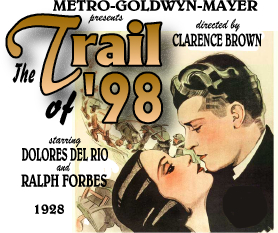

Metro-Goldwyn-Mayer
Directed by Clarence Brown
New York Opening - March 20, 1928
Cast: Delores Del Rio (Berna), Ralph Forbes (Larry), Karl Dane
(Lars Petersen), Harry Carey (Jack Locasto), Tully Marshall (Salvation
Jim), George Cooper (Samuel Foote, "the worm"), Russell
Simpson (Old Swede), Emily Fitzroy (Mr. Bulkey), Tenen Holtz (Mr.
Bulkey), Cesare Gravina (Berna's grandfather), Doris Lloyd (saloon
girl and Locasto's "recruiter"), E.alyn Warren (Engineer),
John Down (the little pardner), Ray Hallor (Brother Jim), Ray
Gallagher (Brother Joe), Edward Connelly (man who brings news
of the gold rush to Samuel Foote), Francis Ford (gold commissioner)
"The Trail of '98" is a movie that tends to get little recognition today. It certainly fits into the "epic" category, and director Clarence Brown has not only created a visually impressive spectacle, he ensures the characters are not overshadowed by the subject, but, instead, offers intimate and bold personalities that make for an emotionally charged viewing experience.
First, the cinematography. The film is visually impressive
because of location shooting in Colorado and Alaska, as well as
California, of course. Brown did his First, the cinematography.
The film is visually impressive because of location shooting in
Colorado and Alaska, as well as California, of course. Brown did
his research on locations and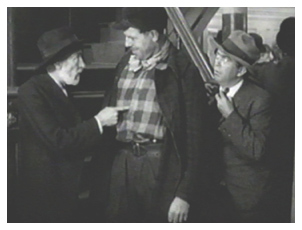 viewed
hundreds of photographs from the actual gold rush in order to
give close attention to detail and realism. One is impressed with
the look of the film from the very first when the opening intertitle
tells us "July 14th, 1897 - A boat from Alaska sailed into
San Francisco harbor . . . and upset the world." The look
and feel of the late 1890's is there, and the crowds (an impressively
large crowd of extras, I might add) at the dock are very much
bedraggled, scruffy, and ordinary looking while others are suited
with bowler hats, just as we would expect.
viewed
hundreds of photographs from the actual gold rush in order to
give close attention to detail and realism. One is impressed with
the look of the film from the very first when the opening intertitle
tells us "July 14th, 1897 - A boat from Alaska sailed into
San Francisco harbor . . . and upset the world." The look
and feel of the late 1890's is there, and the crowds (an impressively
large crowd of extras, I might add) at the dock are very much
bedraggled, scruffy, and ordinary looking while others are suited
with bowler hats, just as we would expect.
After the opening has introduced us to characters in South Carolina, Tennessee, Colorado and other points around the country, we see this myriad of backgrounds and social statuses crowded onto the ship bound for Alaska, a trying and difficult journey in itself - but nothing compared to what is ahead for the unsuspecting gold seekers. The scenes here are moving and, with minor inconveniences, make an appropriate transition to the life-threatening hardships to come. Arriving in Alaska is only a small piece of the journey. In a glaring example of naiveté, Mr. Bulkey tells his wife, "Thank God, Mama, the worst is over," little knowing what is ahead.
Of course, the most compelling scenes are the days of trekking over the wasteland that is required to reach the Klondike where the gold can be found. We see blizzards - very real blizzards - bitter cold, unbelievable wading through waist-deep water in these bone-chilling temperatures, horses stuck in the mud up to their bellies - how could anyone survive this? The meandering and infinite line of people disappearing in the distance as they trek up the Chilkoot Pass is a scene reminiscent of Chaplin's "The Gold Rush," but, obviously, not being a comedy, Brown's visualization is much harsher and intense.
When the spring thaw comes, we sympathize as each character fights an onslaught of mosquitoes, ice moves with the current of the river, and mud abounds. Then, in make-shift boats, they challenge the life-threatening rapids, some not surviving this part of the trip. Rear screen projection takes away some from the realism, but shots of stuntmen who actually rode the rapids of the Copper River in Alaska are intertwined and make for exciting viewing.
Finally, the ones who have survived arrive in Dawson City - as dark, rustic and realistic a frontier town as one could imagine. Chaplin has been criticized for creating cheap sets in "The Gold Rush," but not so for "The Trail of '98." One can feel that this is the way it was.
As noted earlier, it is possible when making a film of this magnitude, that the characters are lost in the spectacle of it all; however, Brown ensures that the characters are the focal point of the story, and the Gold Rush of '98 provides only the backdrop for their tales. There is a large cast, here, but the main characters are Dolores Del Rio (who held top billing on this film) as Berna and Ralph Forbes as Larry. The romance that develops between the two is charming, and their meeting on the boat to Alaska is excellently played as Larry, a stowaway, hides in Berna's and her blind grandfather's cabin. One scene shows them sitting on the floor eating grapes and enjoying their time together without the knowledge of Berna's sleeping grandfather - a charming scene that is not particularly helped by the singing of the movie's theme song, "I Found Gold When I Found You," on the soundtrack.
Although they are the main characters, top acting honors
must go to Harry Carey, who, rather than the likeable western
hero we are accustomed to him portraying, he is the 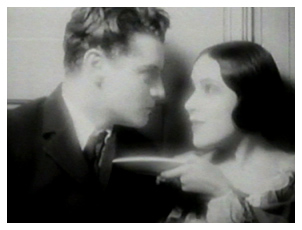 villain
in this picture, and an excellent one, at that. He is the first
to arrive in San Francisco the year before with a million in gold
and thus ignites the flames of desire for riches. He returns to
Alaska with this group chewing on his cigar, asserting his superiority
to the others, traveling in much more comfort than this rag-tag
group who surround him, and continuing to indulge in his practice
of jumping claims. As the infamous Jack Locasto, he is very much
a ladies' man, and his latest target is Berna.
villain
in this picture, and an excellent one, at that. He is the first
to arrive in San Francisco the year before with a million in gold
and thus ignites the flames of desire for riches. He returns to
Alaska with this group chewing on his cigar, asserting his superiority
to the others, traveling in much more comfort than this rag-tag
group who surround him, and continuing to indulge in his practice
of jumping claims. As the infamous Jack Locasto, he is very much
a ladies' man, and his latest target is Berna.
Adding comic relief to the film are Karl Dane as Lars and George Cooper as Samuel Foote - or "the worm" - who join forces with Tully Marshall (not a comic role) as the very religious Salvation Jim - the three of whom form somewhat of a triumvirate to search for gold - eventually taking on Larry as one of their group. Dane added much to "The Big Parade" (1926) with his big dumb lummox persona, and he does equally well in "The Trail of '98." The diminutive (at least alongside Dane) George Cooper as "the worm," provides a perfect counterpart for Dane. Lars is the big, strong, hard-working miner, and the running joke throughout the film is "the worm's" ingenious ways of diverting the work to Lars rather than doing it himself. Jim, of course, is seen as the wise counsel, but plays a pivotal role later in convincing Larry to stay in Alaska instead of going home as a failure - a decision that proves to be the most harmful for Berna.
A couple of minor roles in the film add some sentimentality - E. Alyn Warren as a train engineer and Johnny Downs as the young boy (maybe mid-teens?) whom he finds stowed away on his train. Taking a liking to the boy, they travel together to participate in the gold rush. Their alliance is one that touches the heart, too. At one point as the large contingent of hopefuls is on the trail, they must wade through a large creek waist deep, and the young boy can't stand the cold any longer, nearly panicking. The engineer carries his "little pardner," as he calls him, on his back. The relationship between these two turns to sadness; however. As Salvation Jim is in the line going up the Chilkoot Pass, he sees the engineer sitting on the mountainside with his "little pardner" lying on the ground beside him. The engineer is crying because the boy has succumbed to the strains of the journey.
The conflict between Larry and Locasto is established while they are on the boat between San Francisco and Alaska. In the saloon, Locasto is gambling very successfully at the roulette table. One of his chips falls to the floor, and it appears Locasto hasn't even noticed. Larry picks it up, places it on a bet, and wins. However, Locasto takes the chips telling Larry, "Thanks for picking the winner. That was my chip." Larry replies, "You can't swipe what's comin' to me!" to which Locasto says, "Take your time, sonny. You'll get what's coming to you" and knocks Larry to the floor. Looking up, he sees Berna watching from the balcony, and gets up to confront Locasto again. Locasto knocks him to the floor again with one punch - establishing very clearly who is the superior. However, as movies go, we know they will have an encounter at some point later, and Larry will emerge the victor - and that is exactly what happens.
Once they arrive in the Klondike, Larry, Salvation Jim, Lars and "the worm" leaves for what it obviously weeks, or even months, of prospecting. During this time, Berna has been happy working in the restaurant run by Mr. and Mrs. Bulkey - however, she doesn't realize the restaurant is owned by Locasto. With business poor, Locasto offers to pay the couple's passage back home, an offer they readily accept. However, that leaves Berna on her own, broke but forever faithful to wait on Larry's return. This, of course, is all a part of Locasto's plan.
However, this problem seems to be resolved when Larry returns. He is disgusted, broken, and feeling very much the failure. She begs him to return home with her - forget the riches - they have each other. Larry agrees, and the two are not only relieved but overjoyed with their decision. Larry goes to find Salvation Jim to get money for the passage home - however, Salvation Jim convinces Larry that they should go with the others who are leaving that night to a new gold strike that has been found - and they must leave now. Larry's desire for riches consumes him, and he returns to tell Berna what he feels is good news. Berna is distraught, but doesn't hold him back.
Berna is destitute with no income and scraping the last
bit of food from a can when one of the saloon girls comes to her
and offers to take her in. Of course, Berna is ecstatic at this
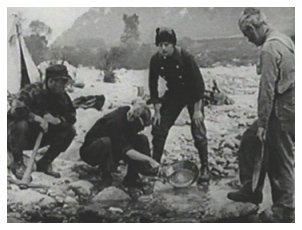 generosity, and she enjoys the
rustic luxury of the girl's room lying on a divan in a clean,
fluffy nightgown. What she doesn't know is that the girl works
for Locasto. So, the girl leaves, and Berna is lying on the divan
when, a few minutes later, Locasto enters the room. As he approaches
Berna, she faints in fear, and the scene fades as we see Locasto
hover over her.
generosity, and she enjoys the
rustic luxury of the girl's room lying on a divan in a clean,
fluffy nightgown. What she doesn't know is that the girl works
for Locasto. So, the girl leaves, and Berna is lying on the divan
when, a few minutes later, Locasto enters the room. As he approaches
Berna, she faints in fear, and the scene fades as we see Locasto
hover over her.
As expected, Berna ends up working in the saloon and being Locasto's "kept woman" - what else can she do? But when Larry returns having struck it rich, he finds Berna finds in the saloon, but is still not aware of the situation with Locasto. He tells her he has struck it rich and shows her a large bag of gold. Berna screams at him in the middle of the dance floor, "So you've found gold? There's not enough gold in the world to make things right again!" Later, in her room, she stares blankly at the floor as Larry begs her to speak to him and declares his undying love for her. When Locasto enters the room, Larry finally realizes what has happened, but continues to profess his love for Berna and that the past doesn't matter. When she leaves the room, Larry challenges Locasto to fight.
Again, the acting honors go to Harry Carey. The cockiness, if you want to call it that, or self-assuredness at taking Larry down as he did before is exemplified by Locasto's slow moving preciseness in preparing the room for the fight. He takes his cigar, flicks the ashes, and sets it on a shelf so it will be undisturbed; he moves the oil lamp from the table out of the way; he then moves a chair to one side, as well as a table. As a final insulting touch, he buttons his coat rather than taking it off. When Larry walks up to him, as expected, Locasto punches him in the jaw, and Larry reels backward - but he doesn't fall. The surprise is evident on Locasto's face. A most realistic, bloody and action-packed fight ensues. Carey is superb in this role, menacing, confident, and utterly despicable.
Del Rio is also superb - very charming and tender in the scenes with Forbes - and, of course, always beautiful. Her most compelling performance, though, is in the scenes following her rape by Locasto. She has stoicly resigned herself to the life that circumstances have forced her into. She is dancing (you can see the disgust on her face) with one of the men in the saloon when Larry comes in. When Larry tells her he's struck it rich, the anger as she slings the contents of the bag around the room is emotion at its zenith. Later in her room, Larry is in tears begging her to take him back, but she has given up knowing the life she has been leading - a life of which Larry is not yet aware. Del Rio's performance wrings every ounce of emotion from the viewer.
Forbes does not measure up to Del Rio or Carey in his performance. It is certainly an animated portrayal and gives a sufficient level of boyish charm. However, he in no way impresses as someone who could either weather the trials of an Alaskan gold rush nor take on someone such as Locasto. Expressively, Forbes is constantly wide-eyed as if in terror rather than conveying the anger or determination the part calls for. In all fairness, he gives the part a great deal of emotion and effort, but he just doesn't click in this role which could have been played much more effectively by many other leading men of the day.
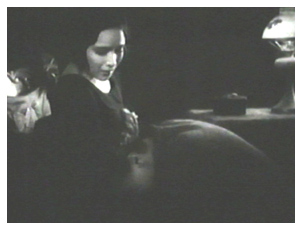 With a $1.5 million price tag,
"The Trail of '98" was one of MGM's most expensive and
ambitious projects to date. Although Brown worked on the project
for a year, total shooting time was 116 days, from March 7 to
July 13, 1927. In addition to below zero conditions at times for
the crew, the film also claimed an undetermined number of lives.
The rapids scene, for example, was responsible for at least three
lives lost. Crews were sent to Cordova, Alaska, for this part
of the film, and, unfortunately, the Copper River and the primitive
boats that were intended to replicate conditions during Gold Rush
days, proved fatal for some. (1) Brown also admitted in an interview
years later with Kevin Brownlow that some lives were lost in a
snowslide while filming in Colorado. (2)
With a $1.5 million price tag,
"The Trail of '98" was one of MGM's most expensive and
ambitious projects to date. Although Brown worked on the project
for a year, total shooting time was 116 days, from March 7 to
July 13, 1927. In addition to below zero conditions at times for
the crew, the film also claimed an undetermined number of lives.
The rapids scene, for example, was responsible for at least three
lives lost. Crews were sent to Cordova, Alaska, for this part
of the film, and, unfortunately, the Copper River and the primitive
boats that were intended to replicate conditions during Gold Rush
days, proved fatal for some. (1) Brown also admitted in an interview
years later with Kevin Brownlow that some lives were lost in a
snowslide while filming in Colorado. (2)
The film was also originally 127 minutes long, but, unfortunately because of later cuts, the print that survives today is 87 minutes in length. MGM did lose money on the picture. A decision to run it on a roadshow basis with $2 admission was likely not the best decision, and a return to regular screenings didn't recoup the print cost even including foreign rentals. Various reasons for the film's failure have been proposed - too many similar Alaskan-type stories had been made, talkies drawing away the audiences, weak story, etc., etc. (3) Looking back over the years, Brown himself apparently wasn't pleased with the film. He told Brownlow, "Story-wise, direction-wise, and acting-wise, I was never too happy with it," he said. "It was just one of those conglomerates." (4)
Variety praised "The Trail of '98" but
felt the love interest was lacking. "'Trail' probably holds
more spectacular sequences than any of the real $2 picures since
'10 Commndments.' Yet, its story never brings a lump to the throat
althogh, at various times, it grips. Dramatic intensity in the
love theme is lacking until avouit the start of he final two reels."
(5)
The New York Times declared, "Although this highly
exciting screen contribution is not without its melodramatic moments
and its flashes of symbolism, there are a numbe rof passages that
would arounse the most blasé individual from his lethargy.
This pictur is to those days of adventure of lust, greed and numbed
finer feelings, what the 'Iron Horse' was to the railroad and
'The covered Wagon' to the West. It is a picture produced and
acted with muc sincerity and earnestnmess, one in which both the
drama and the comedy have evidently been inspired by actual occurrences."
(6)
Prior to writing "The Trail of '98" in 1909, Robert Service was a banker by trade and had been sent to a bank in the Yukon by his Canadian bank in 1904. He was intrigued by the frontier life that still existed in Whitehorse, where he was located, and wrote and recited poems locally for his own pleasure. His two most famous poems, "The Shooting of Dan McGrew" and "The Cremation of Sam McGee" were very popular, and when he submitted a book of his poems for publication was surprised at the reception it received. Listening to the stories of the 1898 gold rush led to his first novel, "The Trail of '98." Service lived in Whitehorse and Dawson City until 1912. Although he was 41 years old, he tried to enlist when World War I broke out, but he was turned down and became a stretcher bearer and ambulance driver, instead. His writings had made him famous, and he enjoyed living a wealthy life and had at least three of his novels made into silent movies. He spent most of the rest of is life in France, continuing to write successfully, and passing away in 1958. (7)
Warner Home Video provides an excellent copy of the film, sometimes low on contrast, but overall very good picture quality. It includes the original music score and sound effects which complement the story well. The sound effects are not distracting and are essentially limited to crowd noise and the constant whistling of the wind - which actually increases the "chill" the viewer feels when watching the snow scenes.
References
1. "The Trail of '98." Wikipedia.
2. Browlow, Kevin. The Parade's Gone By. University of
California Press. 1968.
3. Wikipedia.
4. Brownlow.
5. "The Trail of '98" review. Variety. March
28, 1928.
6. "The Trail of '98" review. The New York Times.
March 21, 1928.
7. "Robert Service." Wikipedia.
Copyright 2014 by Tim Lussier. All rights reserved.